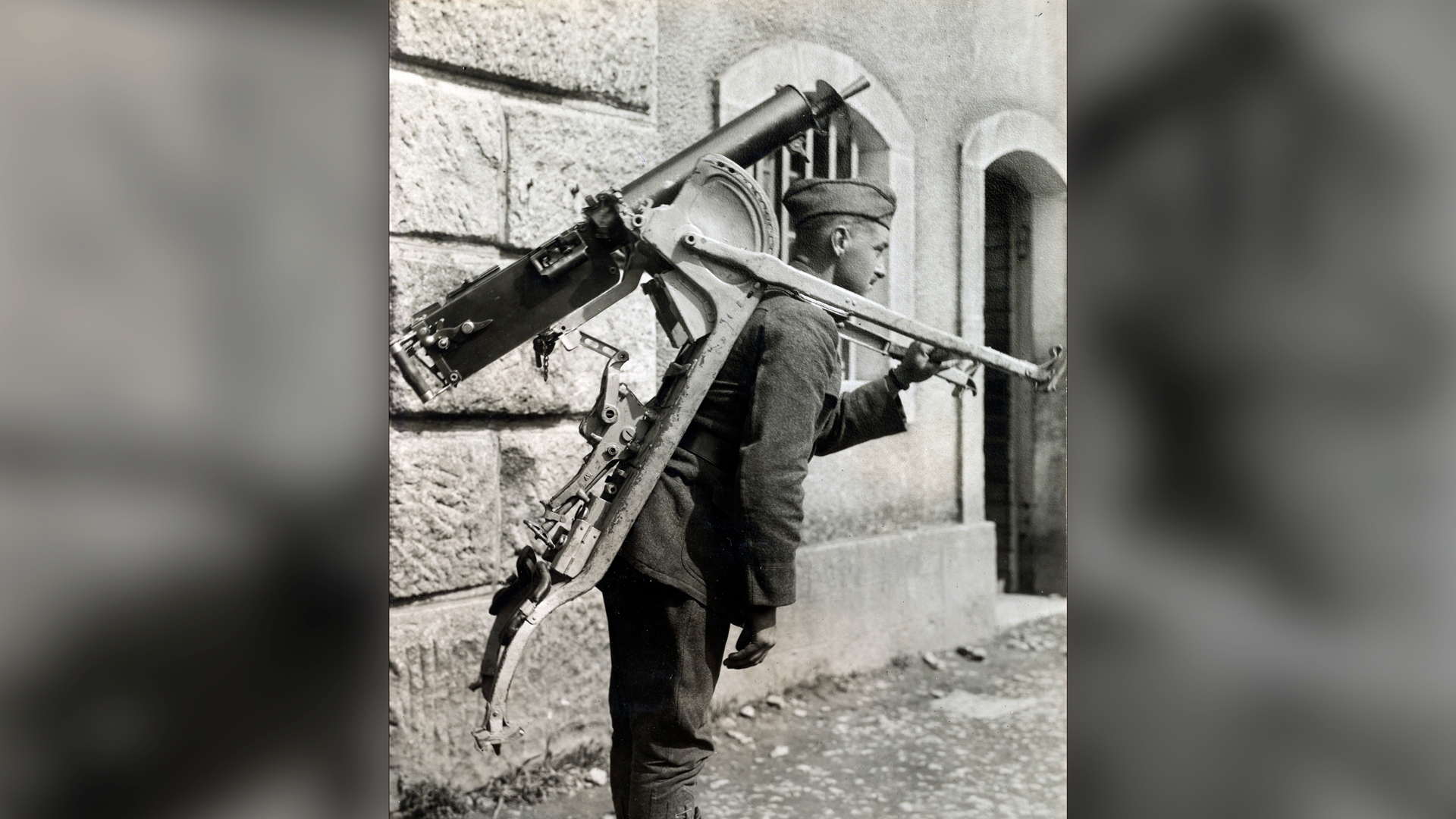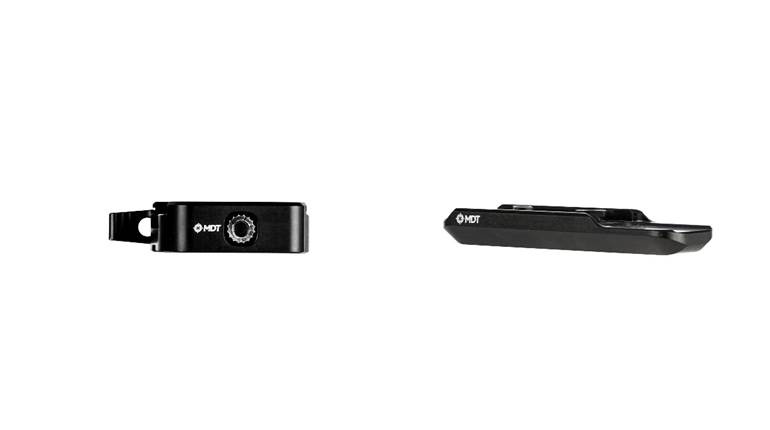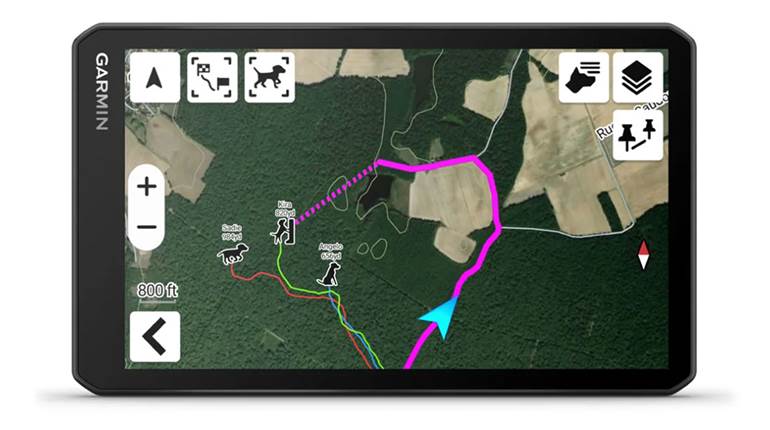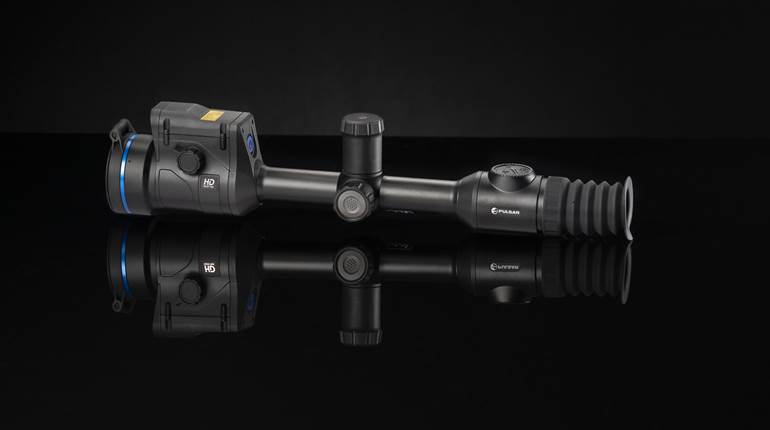
Dating back to World War I, the story of machine guns has been an ongoing struggle to find a balance between portability and sustained firepower. Considering that as of May 2024, there are still Great War machine guns in use in the war in Ukraine, the portability versus sustained fire debate has not yet been fully resolved.
Turning back the clock to 1916, the Kaiser’s troops were in search of as much portable firepower as they could get. At that time, Germany lagged far behind in the development of light, or at least “lighter” machine guns. Across No Man’s Land in their opponents’ trenches, the British had the excellent Lewis Gun (28 lbs., 47-round drum magazine) and the French had their much-derided Chauchat, the Machine Rifle Model 1915 CSRG (20 lbs., 20-round magazine).
In the opening days of the Great War, the Germans weren’t particularly interested in a light machine gun. The ferocity of the combat, coupled with the frustrating nature of the bogged-down, bloody slogging matches on the Eastern and Western Fronts soon changed their thinking.
 German troops with a pair of true light machine guns: the British Lewis Gun (.303) and the Madsen M/1902 (8 mm Mauser) machine rifle.
German troops with a pair of true light machine guns: the British Lewis Gun (.303) and the Madsen M/1902 (8 mm Mauser) machine rifle.
At first, German officers had little respect for any automatic gun that could not provide sustained fire, as their doctrine dictated. And when it came to accurate, sustained fire, there was nothing better than Germany’s Maschinengewehr 08. Weighing in at 152 lbs., counting the gun with a full water jacket plus the massive “Schlitten 08” sledge mount, the MG08 was the pinnacle of stability. Operated by a trained gunner, supplied with plentiful ammunition, and placed in a fortified position, the MG08 could dominate a World War I battlefield out to 2,000 yards. However, moving the MG08 in combat was incredibly awkward and put the crews in considerable danger. Consequently, interest in light machine guns began to grow in the ranks of the German military—even though the army had no official definition of a light machine gun at that time.
In 1915, German successes on the Eastern Front yielded a windfall profit of captured guns, with about 400 Madsen-Rexer M/1902 machine guns taken from Imperial Russian forces. These gave the Germans their first real experience with a light machine gun, and many were converted from the Russian 7.62x54 mm R to the German 8 mm Mauser to create the “Light Automatic Musket M15.”
 The MG08 and the MG08/15 compared. Captured by U.S. troops in France, September 1918. Photo courtesy of National Archives & Records Administration (NARA).
The MG08 and the MG08/15 compared. Captured by U.S. troops in France, September 1918. Photo courtesy of National Archives & Records Administration (NARA).
As the Madsen weighed a little more than 20 lbs. with a 25-round magazine, its easy portability fit the doctrine of the German army’s new “Musket Battalions,” units designed around the evolving concepts of rapid fire and movement for the infantry. With this small group of Madsen guns, the Germans suddenly had a light machine gun that was the approximate equal of the British Lewis and a better machine rifle than the French Chauchat.
However, the Madsen suffered from “Not-Invented-Here,” a syndrome that has afflicted many firearms with good potential throughout the ages. To be fair, the Madsen was expensive for the time, and the Germans were looking for a sustainable, home-grown solution to their light machine gun problem. And, depending on who you ask, they sort of got one.
Enter The MG08/15: A Water-Cooled Compromise
Germany’s task of creating a light machine gun in 1915 proved much more difficult than anticipated. The war was increasing in intensity, and the need for the new light machine gun was immediate. The scope of the project was also larger than expected, as the new gun was “expected to replace the existing heavy MG08s in the forward battle line.”
So the German light machine gun was not conceived to be a supplement to the firepower of the heavy machine gun—as the British and French used them—but rather to replace the heavy machine gun in many combat roles. Germany’s quest for a “Einheitsmaschinengewehr” (universal machine gun) had begun—a journey that would continue into the Second World War. The water-cooled MG08/15 is far from the multi-role, general-purpose machine guns we are accustomed to now, but there are some very good reasons for its “steampunk” appearance.
 The MG08/15 carried on the shoulder during World War I. Photo courtesy of National Archives & Records Administration (NARA).
The MG08/15 carried on the shoulder during World War I. Photo courtesy of National Archives & Records Administration (NARA).
Beyond the previously described Madsen, Germany had few other options for a light machine gun. There was the air-cooled, 28-lb. Bergmann MG 15nA, an advanced design for the era that was developed at the same time as the MG08/15. But despite Bergmann’s modern appearance, the MG 15nA was prone to overheating after little more than 300 rounds of sustained fire. Only about 5,000 were made, and most of the Bergmann guns were issued to troops on the Eastern Front.
Meanwhile, production of the MG08/15 became the top priority. The MG08/15 was produced by seven manufacturers, yielding a total of 130,000 guns by the end of World War I. The government arsenal Spandau Gewehrfabrik built about 50,000 MG08/15s, and British troops often used the nickname “Spandau” to denote the light variant of the German Maxim. The moniker Spandau hung around in World War II as well, as British troops gave the second generation of German light machine guns the same nickname.
Machine gun expert and noted Maxim gun researcher Dolf Goldsmith describes the MG08/15 as “extremely difficult” to shoot accurately from its bipod. Dolf’s tremendous experience with the gun, along with the overwhelming body of historical evidence backs up this assessment. But when judging the MG08/15’s accuracy, I believe it is important to note which machine guns it is compared to. Tripod-mounted guns of the Great War were exceptionally accurate, so comparing the MG08/15 to them is misleading. Light machine guns of World War One is a bit of a jumbled classification—the accuracy of the Lewis gun was good, but not necessarily great, and the accuracy of the Chauchat was even less so. Compared with somewhat similar guns, the MG08/15 performed adequately.
 Portrait of a MG08/15 team in World War I. The gun was a compromise that left much to be desired. Photo courtesy of National Archives & Records Administration (NARA).
Portrait of a MG08/15 team in World War I. The gun was a compromise that left much to be desired. Photo courtesy of National Archives & Records Administration (NARA).
Now & Then
After World War I, there was a tremendous amount of effort invested by gun manufacturers around the world to create effective light machine guns. There have been many notable successes among the many designs, but the challenge of maintaining sustained fire with lightweight, air-cooled guns remains.
While absolutely no one longs for a revival of the MG08/15, we tend to view the gun rather harshly through our contemporary eyes. To many, water-cooled machine guns seem like ridiculous artifacts of our firearm past, and a “light” machine gun with a water jacket appears to be a joke. Even so, the MG08/15 was Germany’s most common machine gun in World War I, and the Germans developed their late-war assault tactics around it. It is clear the German machine gunners of more than a century ago found ways to make the 08/15 work. I dug up World War I documentation to discover what the Germans and their opponents thought of the gun and how it was used.
 German troops training with the MG08/15 during World War One. Photo courtesy of the Library of Congress.
German troops training with the MG08/15 during World War One. Photo courtesy of the Library of Congress.
The British General Staff produced the Handbook of the German Army in War, April, 1918, and this contains a thorough, yet succinct description of the modifications that created the MG08/15:
The '08/'15 light machine gun, though water-cooled, can be carried and operated by one man. It has been evolved from the '08 pattern machine gun by making the following changes:
(A) The diameter of the barrel casing has been reduced from 5.3 inches to 3.5 inches, and its capacity from 7 to 5 pints.
(B) The thickness of the breech casing has been reduced from .16 inch to .12 inch.
(C) The ejector tube has been discarded. The empty cases are ejected through an aperture in the front of the breech casing.
(D) The rear cross-piece has been replaced by a rifle butt and pistol grip. (The grip contained the manual safety)
(E) The sledge mounting has been discarded for a bipod with adjustable pivot.
(F) The gun is fitted with a rifle sling.
The ballistics are similar to those of the '08 pattern machine gun, but the light machine gun is not so accurate. Belts containing either 100 or 250 rounds are used.
-
- Total weight, with barrel casing filled: 43 lbs. (with bipod).
- Weight of water filling: 6 lbs. (5 pints).
- Length (overall): 53 inches.
- Length of butt: 1 foot.
- Height of axis above the ground: 11 inches.
- The gun is fitted with a muzzle attachment and flash obscurer.
Ammunition could be fed from the standard 250-round fabric belt, or the short 100-round belt could be used in the attachable drum (Patronenkasten 16). The fabric belts were sensitive to dampness, and if wet, they could be stretched and distorted, causing problems with extraction. The belt-carrying drum ostensibly made the MG08/15 suitable for use by one man, but in practice, this was rare.
 Details of the ammunition belt drum (showing the internal spool) and the simple bipod of the MG08/15. The Patronenkasten 16 was intended to allow the MG08/15 to be operated by one man—at least as long as 100 rounds of ammunition lasted. Image courtesy of National Archives & Records Administration (NARA).
Details of the ammunition belt drum (showing the internal spool) and the simple bipod of the MG08/15. The Patronenkasten 16 was intended to allow the MG08/15 to be operated by one man—at least as long as 100 rounds of ammunition lasted. Image courtesy of National Archives & Records Administration (NARA).
A sling was provided for transport, and German training materials showed the 43-lb. MG08/15 used with the sling in the “assault fire” mode. Much like the U.S. “walking fire” concept for the Browning Automatic Rifle, it was unlikely to have been used regularly in combat.
By the spring of 1918, the MG08/15 was the prime German machine gun. Regardless of the concerns about its weight, the MG08/15 was fully integrated into the Kaiser’s new infantry assault tactics, focused on speed, maneuver and firepower. These were described in a document from the German HQ on the Western Front, dated April 6, 1918:
“The time has passed when it was sufficient to engage machine guns with a view to obtaining isolated successes at decisive points in infantry combat. The value of the machine gun in defense is well known, in attack it is only now being tentatively grasped.”
 MG08/15 position captured by U.S. troops during the autumn 1918 offensive. Photo courtesy of National Archives & Records Administration (NARA).
MG08/15 position captured by U.S. troops during the autumn 1918 offensive. Photo courtesy of National Archives & Records Administration (NARA).
As the Germans expanded their spring offensive, starting March 21, 1918, their doctrine demanded that they bring their machine guns to the point of attack.
“The great material and moral effect of the machine gun fire must be allowed full play in the infantry attack. The machine gun groups must fight in close cooperation with the groups armed with the rifle, care being taken that they do not mutually impede each other’s action.
The light machine gun groups (each of one NCO and eight men, with one light machine gun) which are to be equipped for independent action (rifles, pistols, hand grenades, entrenching tools) form, owing to their great mobility and concentrated firepower, the framework of the infantry attack. They carry on the fire fight, if necessary, without any groups of riflemen.
Their task is to secure the advance of their own infantry, within the sectors allotted to them, by keeping down the fire of the enemy’s front line, and of any hostile machine guns which remain intact. It is the duty of all commanders, as the attack progresses, to maintain the full power of the light machine guns, and to arrange for the continual replenishment of ammunition. If the light machine guns are supported in this way, their mobility and firepower will be equal to the greatest demands.”
The MG08/15s would be ineffective without the right men to use them, and the April instructions noted that the officers and men must be at peak physical fitness and that they must understand the technical details of the gun, as well as the new ammunition for anti-tank and anti-aircraft work.
"A quick eye, the capability of forming a decision, and an intimate knowledge of the technical side of a machine gun fire fight, combined with ruthless personal driving power and energy are the attributes that should characterize a machine gun commander."
 The air-cooled successor: A U.S. Ordnance illustration from November 1918 of the MG08/18, encountered in the last weeks of the war. Photo courtesy of National Archives & Records Administration (NARA).
The air-cooled successor: A U.S. Ordnance illustration from November 1918 of the MG08/18, encountered in the last weeks of the war. Photo courtesy of National Archives & Records Administration (NARA).
The U.S. Army’s Survey of German Tactics in the 1918 Campaign provides insight to the use of the MG08/15 through several translated documents:
"The machine gun is the principal infantry gun and forms the skeleton of its combat formations. The technical and tactical principles of its employment must become second nature to the soldier."
The survey described the German use of the MG08/15 as follows:
"It is a principle of the Germans that the light machine gun is not an auxiliary gun but as important a means of combat of the infantry as the rifle. It is carried well forward on the very crest of the advance and even in the open country it often precedes the rifle groups."
MG08/15 Importance:
"The light machine gun is the infantry gun and that the company of infantry has become, so to speak, a company of light machine guns. Its main fire strength, in the attack as well as in the defense, rests in the light machine gun, which corresponds to the power of 30 rifles and even more."
 The great bulk of the MG08/15 with its 100-round ammunition belt drum is seen during training exercises in 1939. Photo courtesy of author.
The great bulk of the MG08/15 with its 100-round ammunition belt drum is seen during training exercises in 1939. Photo courtesy of author.
The Air-Cooled MG08/18
Late in World War I, the Germans made another attempt lighten their machine gun, creating an air-cooled variant of the MG 08/15, which was designated MG 08/18. The MG08/18s featured a heavy barrel with a perforated jacket that could only be changed an armorer. The MG08/18 was used in small numbers in the last few months of the war and remained in service through the 1920s. The following U.S. Ordnance report is neither overly impressed or overly critical of the air-cooled MG:
The ‘08/18 Machine Gun US Army General Staff (Intelligence), General Headquarters, 2nd November 1918
New parts:
The water jacket of the ‘08/15 gun has been replaced by a barrel casing 1 ½” outside diameter, perforated with numerous holes to all the free circulation of air around the barrel. At the rear end of the barrel casing, the diameter has been increased slightly to take a clamp with a circular bearing to which the bipod is attached, allowing for all-around traverse. This clamp is always left on the gun.
At 1 ½” in front of the bipod clamp is a handgrip with a wooden handle attached, which enables the gunner to lift the gun without burning himself.
At 4 ¾” in front of the handgrip is a ring for attaching the fore-end of the sling.
The foresight standard is 2 ½” high, this is necessitated by the decreased diameter of the barrel casing. On the front face of the standard are two studs and a threaded hole, probably used for attaching the anti-aircraft foresight.
 Men of the U.S. 150th MG Battalion examine a MG08/15 in France during August 1918. Photo courtesy of National Archives & Records Administration (NARA).
Men of the U.S. 150th MG Battalion examine a MG08/15 in France during August 1918. Photo courtesy of National Archives & Records Administration (NARA).
Firing test:
At preliminary tests, 500 rounds were fired as quickly as possible. The gun only had a few stoppages, owing to trouble with the belt. At the end of the test, the gun appeared to be in serviceable condition.
Comparative Weights:
Gun and bipod: 40 ½ pounds water jacket filled (MG08/15) and 32 pounds (MG08/18)
Filled belt, drum, and holder: 11 pounds (both)
Total weight in action: 51 ½ pounds (MG08/15) and 43 pounds (MG08/18)
Soldiering On
The story of the MG08/15 did not end with the Armistice of November 1918. The gun that was a capable, albeit uncomfortable compromise in 1917-18, was unchanged and still in service at the start of the Second World War. The 08/15 had been useful for training during the interwar period, and during the invasion of Poland in September 1939, small amounts of MG08/15s went into combat to make up for the shortage of MG34s.
 During World War II, the primary use of the MG08/15 was in the light anti-aircraft role—this one is mounted on the 08/15 AA tripod. Photo courtesy of author.
During World War II, the primary use of the MG08/15 was in the light anti-aircraft role—this one is mounted on the 08/15 AA tripod. Photo courtesy of author.
As World War II continued, the MG08/15 served in secondary roles, often as light anti-aircraft guns—a job that it performed well enough by virtue of being a belt-fed gun. Some were allocated to garrison troops on the Atlantic Wall, as well as in the vast expanses of the Russian front on anti-partisan duties. In the last days of World War II, as the Third Reich crumbled, some MG08/15s were issued to Volkssturm units. It is a rare distinction to lose two world wars—the MG08/15 suffered and fought through them both.
“Null-acht-fünfzehn”: A designation Of Mediocrity
All soldiers have their gripes, most of them legitimate. None of them more so than the poor, miserable infantrymen. Null-acht-fünfzehn, translated literally as "zero-eight-fifteen," was uttered as a form of a curse during World War II, a German version of the GI term “SNAFU.” The term even lives on in Germany today, describing something that is completely average in performance. The MG08/15 worked but not well enough in the eyes of the troops. It was not a good design for a “light machine gun,” but it was a design that was available when it was needed, and it was the first step in the German progression towards a universal machine gun.
Additional Photographs:
 German storm troops with an MG08/15 in Flanders during the spring of 1917. Photo courtesy of National Archives & Records Administration (NARA).
German storm troops with an MG08/15 in Flanders during the spring of 1917. Photo courtesy of National Archives & Records Administration (NARA).
 MG08/15 with its “Patronenkasten 16” 100-round drum carrier for its cloth-ammo belt. Photo courtesy of National Archives & Records Administration (NARA).
MG08/15 with its “Patronenkasten 16” 100-round drum carrier for its cloth-ammo belt. Photo courtesy of National Archives & Records Administration (NARA).
 The MG08/15 was a veteran of two world wars. This example is seen here in training with German troops during the late 1930s. Photo courtesy of author.
The MG08/15 was a veteran of two world wars. This example is seen here in training with German troops during the late 1930s. Photo courtesy of author.
 Liberty Loan incentive: A camouflaged MG08/15 war trophy displayed at war loan rally. New York Gov. Charles Whitman is seen at right. Photo courtesy of National Archives & Records Administration (NARA).
Liberty Loan incentive: A camouflaged MG08/15 war trophy displayed at war loan rally. New York Gov. Charles Whitman is seen at right. Photo courtesy of National Archives & Records Administration (NARA).




































